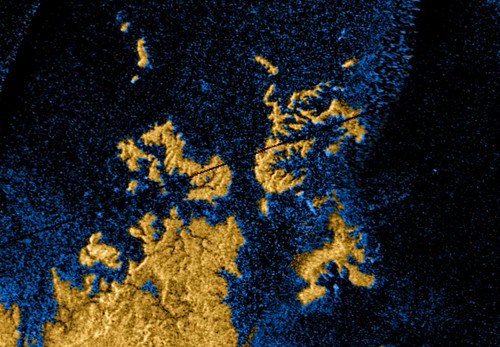
Cassini Image PIA10008 of Northern Polar Region of Titan
For the past week, I have been patiently digitized vegetation layers of Rapa Island and I needed a break. So I cruised some of my favorite websites, this being one of them, JPL's Photojournal with loads of interesting imagery. The Cassini images of Titan are always a favorite with me. The latest news article states that Titan has 100 of times more hydrocarbons then all of the known Earth's supply. This moon of Saturn is extremely cold (-279 degrees fahrenheit). It is enshrouded in clouds and these clouds are full of methane that rains down onto the surface creating methane and ethane lakes and rivers. Oh, yes, with islands!
Beginning with the above image which is a north polar region view with strips of imaged surface laid onto a lat/lon grid. I geocoded the image, using Global Mapper. I then zoomed in on an island rich portion of a very large methane lake and began digitizing island shorelines.

Titan Sea Compared to Lake Superior - Cassini Image PIA09184
Titan is the second largest moon in the solar system. It has a thick atmosphere made up of hydrocarbons. It's size relative to earth is less than 1/2 the size (1000-meters on Earth = 404-meters on Titan).

Titan Island Group - Cassini Image PIA 100008 (1:1,000,000)
This is the area I selected. It has a number of islands just off shore. The scale I worked at was 1:250,000. These are relatively large islands, The larger islands are 49 kilometers in length. They are big islands.

Titan Island Group - Global Mapper Map (1:1,000,000)
And this is the finished map. Simple, yet other worldly. And, now, this is me saying goodnight. It is after midnight and I have a full day with many eager and rambunctious middle school students. I hope you enjoy this unique map of extraterrestrial islands floating in a methane sea.
Enjoy!
No comments:
Post a Comment